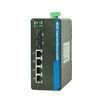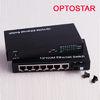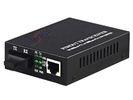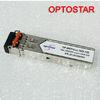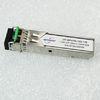2.5GB DDM Small Form Factor Pluggable Transceiver Fiber Optic Module - OP-MP613L1SD
2.5GB DDM Small Form Factor Pluggable Transceiver Fiber Optic Module For Sale, Most Competitive Price, Fast Delivery, Custom Service, Wholesale 2.5GB DDM Small Form Factor Pluggable Transceiver Fiber Optic Module, Made in China, High Quality Products!, China cheap prodocuts, china suppliers Supplier, Manufacturer.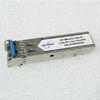
2.5GB DDM Small Form Factor Pluggable Transceiver Fiber Optic Module
?
?
?
Features:
?
?
* Compliant with ITU-T G.957, G.958
* Up to 2.5Gb/s Data Links
* Multi-Source Package with Duplex LC Connector
* Eye Safety Designed to Meet Laser Class1, Compliant with IEC60825-1
* Single +3.3V Power Supply
* Hot-Pluggable
* Monitoring interface compliant with SFF-8472
* Compliant with Bellcore TA-NWT-000983
* RoHS Compliant Products Available
?
?
?
Applications:
?
?
* SDH I-16
* SONET OC48
* 2x Fiber Channel
* Other Optical Links
?
?
Description
?
The SFP-BIDI transceivers are high performance, cost effective modules supporting dual data-rate of 2.488Gbps/2.125Gbps and 40km transmission distance with SMF.
?
The transceiver consists of three sections: a DFB laser transmitter, a PIN photodiode integrated with a trans-impedance preamplifier (TIA) and MCU control unit. All modules satisfy class I laser safety requirements.
?
The transceivers are compatible with SFP Multi-Source Agreement (MSA) and SFF-8472. For further information, please refer to SFP MSA.
?
?
?
?
Absolute Maximum Ratings
?
Table 1 - Absolute Maximum Ratings
?
- - - -
Parameter | Symbol | Min | Max | Unit |
Supply Voltage | Vcc | -0.5 | 4.5 | V |
Storage Temperature | Ts | -40 | +85 | °C |
Operating Humidity | - | 5 | 85 | % |
- - - -
?
?
Recommended Operating Conditions
?
Table 2 - Recommended Operating Conditions
?
- - - -
Parameter | Symbol | Min | Typical | Max | Unit |
Operating Case Temperature | Tc | 0 | ? | +70 | °C |
Power Supply Voltage | Vcc | 3.13 | 3.3 | 3.47 | V |
Power Supply Current | Icc | ? | ? | 300 | mA |
Data Rate | ? | ? | 2.488 | ? | Gbps |
? | ? | 2.125 | ? |
- - - -
? ? ? ? ?
?
Optical and Electrical Characteristics
?
OP-MP645L1SN-40: (DFB and PIN, 1490nm, 40km Reach)
?
Table 3 - Optical and Electrical Characteristics
?
- - - -
Parameter | Symbol | Min | Typical | Max | Unit | Notes |
Transmitter |
Centre Wavelength | λc | 1470 | 1490 | 1510 | nm | ? |
Spectral Width (RMS) | ?λ | ? | ? | 1 | nm | ? |
Average Output Power | Pout | -2 | ? | +3 | dBm | 1 |
Extinction Ratio | ER | 9 | ? | ? | dB | ? |
Optical Rise/Fall Time (20%~80%) | tr/tf | ? | ? | 0.16 | ns | ? |
Data Input Swing Differential | VIN | 400 | ? | 1800 | mV | 2 |
Input Differential Impedance | ZIN | 90 | 100 | 110 | Ω | ? |
TX Disable | Disable | ? | 2.0 | ? | Vcc | V | ? |
Enable | ? | 0 | ? | 0.8 | V | ? |
TX Fault | Fault | ? | 2.0 | ? | Vcc | V | ? |
Normal | ? | 0 | ? | 0.8 | V | ? |
Receiver |
Centre Wavelength | λc | 1530 | ? | 1570 | nm | ? |
Receiver Sensitivity | ? | ? | ? | -18 | dBm | 3 |
Receiver Overload | ? | 0 | ? | ? | dBm | 3 |
LOS De-Assert | LOSD | ? | ? | -23 | dBm | ? |
LOS Assert | LOSA | -30 | ? | ? | dBm | ? |
LOS Hysteresis | ? | 1 | ? | 4 | dB | ? |
Data Output Swing Differential | Vout | 400 | ? | 1800 | mV | 4 |
LOS | High | 2.0 | ? | Vcc | V | ? |
Low | ? | ? | 0.8 | V | ? |
- - - -
?
Notes:
1. The optical power is launched into SMF.
2. PECL input, internally AC-coupled and terminated.
3. Measured with a PRBS 223-1 test pattern @2488Mbps, BER ≤1×10-12.
4. Internally AC-coupled.
?
Timing and Electrical
Table 4 - Timing and Electrical
?
?
- - - -
Parameter | Symbol | Min | Typical | Max | Unit |
Tx Disable Negate Time | t_on | ? | ? | 1 | ms |
Tx Disable Assert Time | t_off | ? | ? | 10 | μs |
Time To Initialize, including Reset of Tx Fault | t_init | ? | ? | 300 | ms |
Tx Fault Assert Time | t_fault | ? | ? | 100 | μs |
Tx Disable To Reset | t_reset | 10 | ? | ? | μs |
LOS Assert Time | t_loss_on | ? | ? | 100 | μs |
LOS De-assert Time | t_loss_off | ? | ? | 100 | μs |
Serial ID Clock Rate | f_serial_clock | ? | ? | 400 | KHz |
MOD_DEF (0:2)-High | VH | 2 | ? | Vcc | V |
MOD_DEF (0:2)-Low | VL | ? | ? | 0.8 | V |
- - - -
?
?
Diagnostics
Table 5 – Diagnostics Specification
?
?
- - - -
Parameter | Range | Unit | Accuracy | Calibration |
Temperature | 0 to +70 | °C | ±3°C | Internal / External |
Voltage | 3.0 to 3.6 | V | ±3% | Internal / External |
Bias Current | 0 to 100 | mA | ±10% | Internal / External |
TX Power | -2 to +3 | dBm | ±3dB | Internal / External |
RX Power | -18 to 0 | dBm | ±3dB | Internal / External |
- - - -
?
Digital Diagnostic Memory Map
?
The transceivers provide serial ID memory contents and diagnostic information about the present operating conditions by the 2-wire serial interface (SCL, SDA).
?
The diagnostic information with internal calibration or external calibration all are implemented, including received power monitoring, transmitted power monitoring, bias current monitoring, supply voltage monitoring and temperature monitoring.
?
The digital diagnostic memory map specific data field defines as following.
?
?
Pin Descriptions
?
?
?
- - - -
Pin | Signal Name | Description | Plug Seq. | Notes |
1 | VEET | Transmitter Ground | 1 | ? |
2 | TX FAULT | Transmitter Fault Indication | 3 | Note 1 |
3 | TX DISABLE | Transmitter Disable | 3 | Note 2 |
4 | MOD_DEF(2) | SDA Serial Data Signal | 3 | Note 3 |
5 | MOD_DEF(1) | SCL Serial Clock Signal | 3 | Note 3 |
6 | MOD_DEF(0) | TTL Low | 3 | Note 3 |
7 | Rate Select | Not Connected | 3 | ? |
8 | LOS | Loss of Signal | 3 | Note 4 |
9 | VEER | Receiver ground | 1 | ? |
10 | VEER | Receiver ground | 1 | ? |
11 | VEER | Receiver ground | 1 | ? |
12 | RD- | Inv. Received Data Out | 3 | Note 5 |
13 | RD+ | Received Data Out | 3 | Note 5 |
14 | VEER | Receiver ground | 1 | ? |
15 | VCCR | Receiver Power Supply | 2 | ? |
16 | VCCT | Transmitter Power Supply | 2 | ? |
17 | VEET | Transmitter Ground | 1 | ? |
18 | TD+ | Transmit Data In | 3 | Note 6 |
19 | TD- | Inv. Transmit Data In | 3 | Note 6 |
20 | VEET | Transmitter Ground | 1 | ? |
- - - -
?
Notes:
?
Plug Seq.: Pin engagement sequence during hot plugging.
1) TX Fault is an open collector output, which should be pulled up with a 4.7k~10kΩ resistor on the host board to a voltage between 2.0V and Vcc+0.3V. Logic 0 indicates normal operation; Logic 1 ? ? ?indicates a laser fault of some kind. In the low state, the output will be pulled to less than 0.8V.
?
2) TX Disable is an input that is used to shut down the transmitter optical output. It is pulled up within the module with a 4.7k~10kΩ resistor. Its states are:
? ? ? ? ? Low (0 to 0.8V): Transmitter on
? ? ? ? ? (>0.8V, < 2.0V): Undefined
? ? ? ? ? High (2.0 to 3.465V): Transmitter Disabled
? ? ? ? ? Open: Transmitter Disabled
?
3) Mod-Def 0,1,2. These are the module definition pins. They should be pulled up with a 4.7k~10kΩ resistor on the host board. The pull-up voltage shall be VccT or VccR.
? ? ? ? ?Mod-Def 0 is grounded by the module to indicate that the module is present
? ? ? ? ?Mod-Def 1 is the clock line of two wire serial interface for serial ID
? ? ? ? ?Mod-Def 2 is the data line of two wire serial interface for serial ID
?
4) LOS is an open collector output, which should be pulled up with a 4.7k~10kΩ resistor. Pull up voltage between 2.0V and Vcc+0.3V. Logic 1 indicates loss of signal; Logic 0 indicates normal operation. ? ? ?In the low state, the output will be pulled to less than 0.8V.
?
5) RD-/+: These are the differential receiver outputs. They are internally AC-coupled 100 differential lines which should be terminated with 100Ω (differential) at the user SERDES.
?
6) TD-/+: These are the differential transmitter inputs. They are internally AC-coupled, differential lines with 100Ω differential termination inside the module.
?
?
Company Profile
?
Shenzhen Optostar Optoelectronics Co., Ltd. was founded in May 2006 and headquartered in Nanshan District, Shenzhen, China. As a leading manufacturer and supplier for fiber optical components and system products in China, we can provide our customers with active components such as GPON/EPON, all serial SFP transceivers, Media Converters, PDH multiplexers, EDFAs, Video Multiplexers which are used for telecommunication, network and security. We are also producing passive components such as Patch Cords, CWDM, DWDM, PLC splitters and so on.
Our company has a lot of advantages based on 10 years of experience in the optical telecommunication industry: Perfect techniques and producing plant, Abundant technology development capability with 10 persons R&D team, Rich OEM & ODM co-operation experience with famous overseas companies, Strong ability to provide whole network solutions. We owned 2 production plants which the total area is more than 6000sqm and more than 300 workers and 50 technicians and 1 headquarter office which has sales team of around 30 persons. After more than ten years of operation, Optostar has successfully developed the worldwide market. Our products are widely accepted by the customer from all of the world and win good reputations by themselves. We promise to provide our customers with high quality products and nice services. To achieve your 100% satisfaction is our persistent goal all along! ?
Shenzhen Optostar Optoelectronics Co., Ltd
Address: A-14,Haide Building,the Intersection of Nanxin Road and Haide Second Road, Shenzhen, Guangdong, China, 518000
Tel: 86-755-26400198
Shenzhen Optostar Optoelectronics Co., Ltd was founded in May 2006, headquartered in Nanshan District, Shenzhen ,China . As a leading manufacturer and supplier for fiber optical components and System Products in China, we can offer our customers with active components, passive components and system

